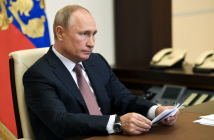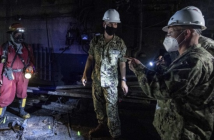Robert Dalsjö, PhD, the deputy director of research at the Swedish Defence Research Agency and co-author of “Bursting the Bubble? Russia’s A2AD-Capabilities in the Baltic Sea Region,” discusses Moscow’s actual military capabilities with Defense & Aerospace Report Editor Vago Muradian at the DSEI 2019 conference and tradeshow in London. Our coverage is sponsored by L3Harris and Leonardo DRS and in partnership with Clarion Events — DSEI’s organizer — and working with the UK Department of International Trade’s Defence & Security Organisation to bring our audience the best in British defense and security.
Vago Muradian: Welcome to the Defense and Aerospace Report. I’m Vago Muradian here at the Excel Center in London covering DSEI, one of the world’s truly great defense conferences covering air, space, sea, cyber security and much more. Our coverage here is sponsored by L3Harris and Leonardo DRS. We’re partnered with Clarion Events, the great organizer of this fantastic event including many others all around the world. And we are working with the UK Department of International Trade, Defence and Security Organization to bring you the very best of British defense once this great show starts. Now it’s Day Zero. The great security conferences — air, land, sea, and space that took place today. And it’s our honor to talk to Dr. Robert Dalsjö who is with the Swedish Defence Research Agency. The Deputy Director of Research there
Robert, absolutely fascinating briefing today on that last panel in the air power group, the Royal Air Force Session, where you were talking about, you and your colleague were talking about Bursting the A2, Michael Jonsson who partnered with you on this project, Bursting the A2/AD Bubble.
For years everybody has been talking about Russian supremacy and the anti-access area denial, that the Baltic is a fortress, how formidable the S-400 is, how terrifying the Bastion weapon is, and how incredibly powerful Russian forces became after they invaded Ukraine, whereas a couple of days before they were considered not that good.
Talk to us about the reality and the myth of Russian power and how military planners should be thinking about the Russian threat.
Dr. Robert Dalsjö: I’m very glad for the reception of this report, but also somewhat surprised, because it’s not exactly news that the world is round. And sometimes I feel like the little boy in Hans Christian Andersen’s story about the emperor being naked. All we have pointed out are a few basic things, but people got so hyped up after Russia’s attack on the Ukraine Crimea, and they started to, there was a pendulum swing, you might say, in the assessment of Russia from [basket case]to a menace. And that means that we over-estimated on the Western side Russian capabilities.
Russia is still very dangerous, and it’s brutal and also opportunistic, but when it comes to high tech they don’t really have that much to offer.
Mr. Muradian: Talk to us about your research and some of the limitations you found in your report. You discuss, for example, the S-400 which is billed as a 400-kilometer range. The Bastion missile which is seen as this incredibly formidable weapon, and then also the Iskander. What’s the fact, the myth and the reality about each of these systems?
Dr. Dalsjö: The myth is the circles that we have seen on many maps, even in reputable journals that says that the S-400 system can hit almost anything within a circle with a radius of 400 kilometers. Now that assessment misses, first of all, that the top of the line active radar missile which supposedly has a 400-kilometer range is not yet operational. Ten years after Russia started rolling out the S-400 system, they had not gotten it to work.
Now they say it’s in production, but first for export customer and we’ll see how good it is when it arrives. This means that currently the really operational missile of the S-400 is the 48N6 which is the same missile that arms the S-300 system, much older. It has a nominal range of about 200-250 kilometers, so much less. But even there, the problem with the curvature of the earth comes in. Because the earth is round. It’s easy to draw circles on a flat map, but when you need to draw circles on a globe it’s different because radar beams travel in a straight line.
These missiles, the ones that are operational, they need the radar on the ground to see the target and to designate the target and to illuminate the target with the radar during the whole engagement sequence. This means that the target has to be above the radar horizon. Now if a target flies low, it very easily dips under the radar horizon.
Some of my colleagues who actually are rocket scientists, they assess the S-400’s effective range against small maneuvering targets, so to say flying on the deck. Combat aircraft or cruise missiles flying on the deck, to be somewhere in the region of 20 kilometers rather than 400, and that’s a massive difference.
Mr. Muradian: What about strike weaponry, right? I mean if you look at the Bastion, you’re looking at a weapon that’s advertised as a couple of hundred kilometers, including with hypersonic capabilities. Right? 2.5 Mach or so, which makes it pretty devastating even if it doesn’t detonate when it hits something. But that assumes that it hits something. And then Iskander as well. How do you assess, because when you put those, they’re big rings and they’re also seen as sort of formidable and highly precision weapons.
Dr. Dalsjö: The Bastion-P is supposed to be used against ships, and ships are on the surface. That means they’re not up in the air. Thus a very familiar phenomenon is we have a horizon. We can’t see what’s beyond the horizon. And when it comes to ships, that horizon is about 40 kilometers. So yes, the Bastion-P missile flies fast, Mach 2.5. It can fly far, about 300 or 400 kilometers. But unless it knows where to find its target, flying fast and flying far doesn’t help.
So the Russian system needs to have the targeting data of a sufficient quality to put into the system. And if the Bastion-P only has the organic radar which is in the unit, then it’s limited to the radar horizon and about 40 kilometers range. And this means that in order to protect ourselves against the Bastion-P system perhaps we shouldn’t focus on stopping Mach 2.5 missiles hurtling towards us, but in shooting down any eyes in the sky that might be spotting.
Mr. Muradian: What about Iskander?
Dr. Dalsjö: Iskander is the most talked about Russian missile for about two decades. There’s been a lot of discussion about it.
On the Iskander which is against, a ballistic missile against ground targets, then there is not the same difference between nominal and effective range that we see in the S-400 and the Bastion-P.
But with the Iskander, the problem is numbers. Currently they have a unit with 24 ready missiles in Kaliningrad, plus 24 more reloads. It’s not all that much when you figure all the targets that need to be taken out in case of conflict, when you figure the need to maintain a reserve for nuclear use, when you figure the need to perhaps take out the U.S. missile defense installation in Poland, it’s not all that many missiles that are left.
So we think that the greater threat to ground targets from Russia comes from cruise missiles.
Mr. Muradian: For example the Kalibr.
Dr. Dalsjö: The Kalibr, yes, and also the cruise missile variant of the Iskander which they might tweak now when the INF agreement has expired into much longer range.
Mr. Muradian: By the way, on the S-400, I thought it was very funny that you pointed out that China has been asking for deliveries. But tell us that story because it’s very, very funny. It’s almost Soviet-era kind of funny.
Dr. Dalsjö: Yes. China had been complaining that they had ordered and paid for S-400 systems but had not gotten the advertised top of the line missile, the active 40N6. And the Russians were saying well, it’s almost done, we’re just testing now. It didn’t work. We’ll try another one.
Last autumn, last fall, they said now it’s been cleared for production. And the first batch was going to go to China. And supposedly, according to Russian sources, they loaded these high-tech missiles as deck cargo on a ship which encountered a storm in the English Channel and lost the missiles overboard. So they went back and told the Chinese that we had the products but they were destroyed in transport, which kind of reminds me of Bart Simpson saying the dog ate my homework.
Mr. Muradian: What was interesting was they didn’t recover any missiles from the bottom of the English Channel or anything, and nobody else found any missiles either. Which I think is very telling.
Let’s flip this around. The last question I want to ask, well, there are two questions I want to ask you. One is when we look at taking Russia out, everybody talks about Kaliningrad as a formidable footprint. But that’s not many targets. And even for Russia as a whole, it’s not many targets. So talk to us about, from countering some of these threats, it’s actually something that may be easier for Western militaries than some people would think.
Dr. Dalsjö: Yes, because we tend to see Kaliningrad from our perspective as a menace, as a base for all kinds of long-range systems. But when you see it from Russia’s perspective, it’s vulnerable. It’s an outpost. It’s part of the country that’s cut off from the Motherland with two NATO countries on each side and the sea on the third, and it’s not all that much space. So they put a lot of high value assets there and they become vulnerable even to Polish artillery.
Also the Russians are paranoid by the possibility that parts of Russia might break away, and they are very concerned for any ideas the Kaliningraders might have for greater autonomy. And these could be played on.
So I think the Russian vulnerabilities and sensitivities could be used to our advantage.
Mr. Muradian: Let me ask you about the information threat from Russia. Do you fall into the category of those people who look at Russia’s disinformation capabilities as being more dangerous even than their kinetic military capabilities at the end of the day? Given how much supporting Brexit, supporting Marine Le Pen, trying to undermine Swedish or Norwegian or Baltic democracies and even in the United States and elsewhere.
Dr. Dalsjö: That’s a good question. I asked that to a colleague actually yesterday. I was sitting on an airplane and I sent him an email. Because Russia has acquired both, you might say, the kinetic capabilities for a blitzkrieg with the high readiness units. They are building up the capabilities for a big slog fight with tank divisions of the old style. And they also have their hybrid means and their disinformation. So really they have three different ways of subverting or grabbing one or more Western countries.
I think what is more dangerous, a knife or an axe? It depends on what you’re going to use them for. And Russia has behaved opportunistically during the last 10 or 15 years. They have seen an opportunity and grabbed it. Then of course depending on the character of the opportunity, the tool taken would be either an axe or a knife or a tripwire.
Mr. Muradian: As you guys point out, there are a lot of reasons why Russia boasts like this. One is for internal consumption purposes, one is for international prestige purposes, and the other one is arms sales purposes, right? In order to convince folks. And you say the important thing is also to stand up consistently to them in terms of it being a deterrent.
But one of the things that Russia has taken advantage of, for example, is the recent explosion, the missile test in the White Sea that went wrong. Radioactive isotopes were released in your neighborhood tracked by a lot of countries in the region. And there’s this speculation that it’s the Burevestnik, it’s a nuclear-powered long-range doomsday weapon. But the reality could be far more mundane. I spoke to a Russian military analyst who said actually it’s either one of the deep space batteries which Rosatom works on, or a deep space nuclear propulsion plant which is what you use to get really, really far. You know, you accelerate very slowly over a long period of time.
What sense do you have about what that system was? And how much of this is, again Russian propaganda and disinformation? And how much of it is reality?
Dr. Dalsjö: I would defer to the real specialists. I don’t have any information except what’s out there publicly.
I notice that some American analysts said that it’s not the Burevestnik but it might be the Zircon which is a hypersonic missile that may have one of these radiation batteries to heat the fuel. I don’t know. But something blew up. Something happened and it was radioactive. And it’s also indication of, I’d say the more important thing, it’s an indication of how risk-taking Russia is when it comes to these dangerous and exotic technologies. Whatever it was, it backfired, people died. It spread radioactivity.
Mr. Muradian: And the last question. What’s the best way to deter Russia from your standpoint? Because you’re not a military expert, you’re a political-military diplomacy and strategy expert. What’s the best way to deter Russia?
Dr. Dalsjö: To be strong. To be strong and to be determined. Russians are not fools. They see an opportunity, they use the opportunity to move forward. Because what Putin wants is to make Russia great again, to reestablish its position as a great power. But if they see that the door is closed and it’s guarded, they are not going to try to break it.
Mr. Muradian: Dr. Robert Dalsjö, the Deputy Director of Research at the Swedish Defence Research Agency. Sir, an honor and a pleasure. Fantastic report, Bursting the A2/AD Bubble that you wrote with Dr. Michael Jonsson. Thank you so much.
Dr. Dalsjö: Thank you.
30



